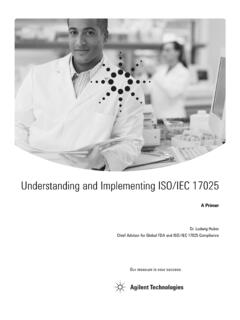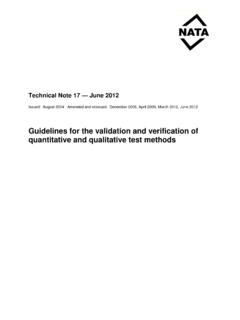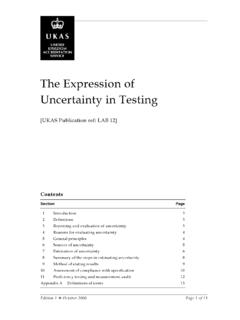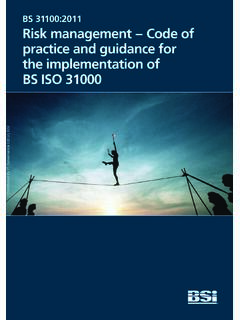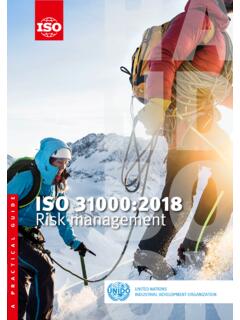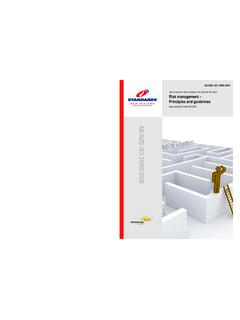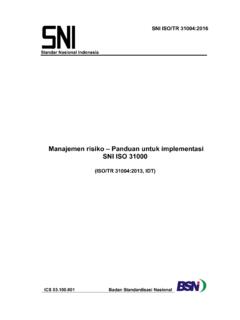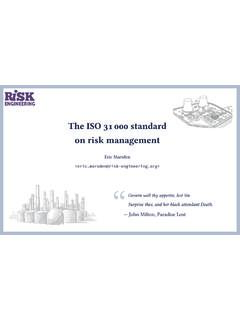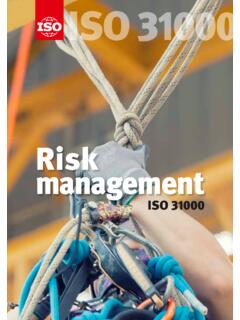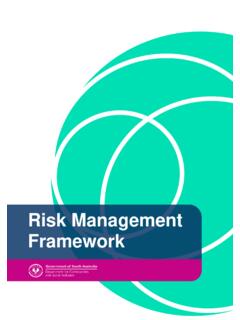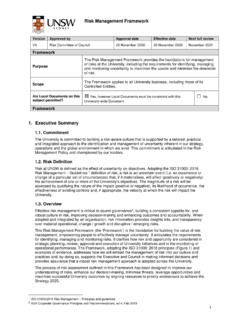Transcription of A Risk Practitioners Guide to ISO 31000: 2018
1 1A Risk Practitioners Guide to ISO 31000 2018A Risk Practitioners Guide to ISO 31000 : 2018 Review of the 2018 version of the ISO 31000 risk management guidelines and commentary on the use of this standard by risk professionals 2A Risk Practitioners Guide to ISO 31000 2018 About IRM Institute of Risk ManagementA company limited by guarantee. Registered in England number 2009507 IRM does not accept any liability to any party for any loss, damage or costs howsoever arising, whether directly or indirectly, whether in contract, tort or otherwise from any action or decision taken (or not taken) as a result of any person relying on or otherwise using this document or arising from any omission from Office: 2nd Floor, Sackville House, 143-149 Fenchurch Street, London, EC3M 6 BNT +44 (0)20 7709 9808E is the leading professional body for risk management .
2 We are an independent, not-for-proft organisation that champions excellence in managing risk to improve organisational do this by providing internationally recognised qualifications and training, publishing research and guidance and raising professional standards across the world. Our members work in all industries, in all risk disciplines and across the public, private and not-for-proft Risk Practitioners Guide to ISO 31000 2018 Contents1. Executive summary 2. Nature of management systems 3. Changing risk context for organisations 4. Structure and approach of ISO 31000 5. Guidance provided by ISO 31000 principles 6. Guidance provided by ISO 31000 framework 7.
3 Guidance provided by ISO 31000 process 8. Comparison of ISO 31000 against Annex SL 9. Relevance of ISO 31000 for risk professionals Appendix A: Structure of ISO management system standards Appendix B: Components of ISO 31000 : 2018 4A Risk Practitioners Guide to ISO 31000 20181. Executive SummaryThere are many recommended approaches to risk management (RM) and several different guides and risk management frameworks and standards have been published. This Guide explains the approach used in ISO 31000 :2018 Risk management Guidelines and identifies the importance and relevance of ISO 31000 and other frameworks. This Guide also outlines the practical application of the ISO 31000 guidelines and provides commentary on implementation.
4 It remains a challenge for risk professionals to clearly demonstrate the value of making resources available for risk management . In view of this continuing challenge, ISO has published an updated version of ISO 31000 Risk management Guidelines. This IRM Guide provides commentary on the revised ISO 31000 . In 2017 COSO published ERM Integrating Strategy and Performance and a separate IRM Guide to the updated COSO framework has also been published. In order to evaluate ISO 31000 and, in the separate Guide , the updated COSO framework, a recognised format is necessary. The International Standards Organisation (ISO) published a highly regarded Guide to the format for management system standards entitled Annex SL.
5 The Annex SL format for management system standards is summarised in Appendix A of this Guide . Annex SL describes seven substantive components of a management system standard. These are grouped in this Guide as Scope and Design components and Control and Develop components, as illustrated in Figure 1 and Figure 2, respectively. This Guide considers these two groups of components as the means of comparing ISO 31000 with the Annex SL format. The conclusion is that ISO 31000 includes all the required features of a management system standard, but with the emphasis on the Control and Develop components. Overall, ISO 31000 provides detailed guidelines on the plan, implement, measure and learn features of a risk management system, but less explicit information on the context, leadership and support features required of a management system standard.
6 An analysis of the components of ISO 31000 is provided in Appendix B. The message for risk professionals is that their employer or client organisations should implement the ISO 31000 principles and components that are best suited to their particular circumstances and modify other principles and components, as necessary. ISO 31000 contains much valuable information and it represents robust, high-level guidelines for the management of risk. However, there is no step-by-step checklist to implementation of the risk management initiative. The challenge for risk professionals is to rearrange the guidance in ISO 31000 to align with their own approach to implementing a risk management initiative.
7 This Guide provides an analysis of ISO 31000 , a comparison with the ISO format for management system standards (Annex SL) and outlines a checklist for the implementation of a risk management initiative in Section 9. 5A Risk Practitioners Guide to ISO 31000 20182. Nature of management systemsA management system is the framework of policies, processes and procedures employed by an organisation to ensure that it can fulfill the tasks required to achieve its purpose and objectives. These objectives will cover all aspects of the organisation, including strategy, tactics, operations and compliance. For instance, a quality management system enables organisations to improve the quality and consistency of products and/or services.
8 ISO has published a Guide to management system standards with information on the sections that should be included. This ISO guidance is published as Annex SL and several standards have already been converted into this format. ISO 9001 on quality management is the best established international standard and was updated in 2015 using the Annex SL format. Several existing ISO management system standards are being converted into the Annex SL format, including ISO 14001 Environmental management systems and ISO 45001 Occupational health and safety management systems. Given the well-established nature of Annex SL and the fact that ISO 9001 has already been converted into this format, it is the most appropriate structure against which to judge the completeness of ISO 31000 .
9 A summary of the Annex SL format is provided in Appendix A. However, ISO 31000 and the COSO framework Enterprise Risk management Integrating with Strategy are not in the Annex SL format. Table 2 in Section 8 of this Guide compares ISO 31000 with the Annex SL format and provides a useful means of testing the completeness of ISO 31000 . In order to review ISO 31000 , the Annex SL components have been grouped into components that consider the Scope and Design and components that consider the Control and Develop features of a management system. The Annex SL components relevant to Scope and Design are context, leadership and support. The components relevant to Control and Develop are planning, operation, performance and improvement.
10 These latter components are equivalent to plan, implement, measure and learn (PIML) or the plan-do-check-act approach used in some management systems. Figure 1 illustrates the relationship between the three components of the Scope and Design and Figure 2 illustrates the relationship between the four components of Control and Develop . Presentation of the Annex SL components in this format separates the Scope and Design components, which represent the framework for supporting risk management from the Control and Develop components which represent the risk management process itself. Formalised management systems have defined, documented processes that are intended to explicitly manage processes within an organisation.
